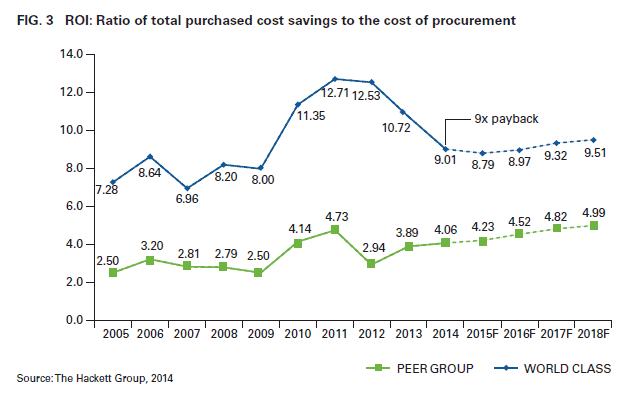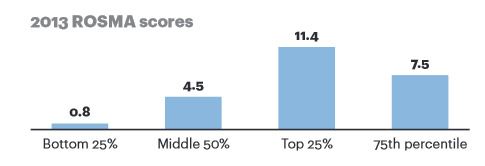Next, last year the analysts and consultants at The Hackett Group produced the following chart, showing the amount of
purchase price savings that procurement leaders generate is more than
double that of the average firm.

Source: The Hackett Group
As can be seen, this data says leaders generate some nine dollars of savings for every dollar invested, versus just over four dollars for middling performers.
Not long after that, a combination of AT Kearney, the Institute for Supply Management, and the Chartered Institute of Purchasing and Supply also issued a new report, based on Kearney's Return on Supply Management Assets (ROSMA) methodology for measuring the value of supply management activities.
It contains the following chart, which shows procurement leaders receive a return equal to about 11 times their investment in the function, while the median company (50% level) achieves a return of just 4.5 on those dollars. The worst companies barely get any return at all, seeing payback equal to less than their investment, at a ratio of just .8.

Source: ATKearney
These last
two sets of numbers measure slightly different things, but are
remarkably similar in their main takeaways: procurement leaders simply
drive considerably more value from what they spend on procurement than
the average company, probably more than twice as much.
So there you have it. In none of these four examples is it very clear how the savings/value difference were calculated across different caliber companies/managers in terms of procurement excellence, but the results across them are almost identical.
The trick, of course, is understanding where your company stands along these lines. We also continue to ponder if there might be some way to apply this same type of methodology to the broader supply chain, but no manageable approach has yet come to us.
Do you think these various analyses showing the huge advantage top tier procurement organizations and managers have over others are right? Can you see anyway of doing this for the broader supply chain? Let us know your thoughts at the Feedback button (email) or section (web form) below.

|